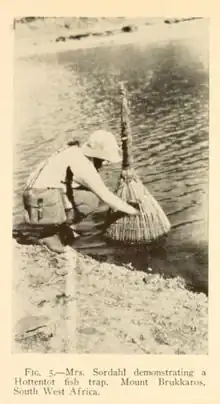Margaret Sordahl | |
|---|---|
 | |
| Born | 1906 Milan |
| Died | 1995 Galveston |
| Occupation | Naturalist, scientific collector, botanical collector |
| Employer |
|
Margaret Sordahl (1906 – 1995) was an ornithologist who worked for the Smithsonian Astrophysical Observatory. She collected two holotype specimens, Erythropygia coryphaeus abboti and Serinus albogularis sordahlae, the latter of which was named in her honour.
Biography
Margaret Froiland was born in 1906 in Milan.[1][2] She married Lois Sordahl, who became Field Director for the Smithsonian Astrophysical Observatory.[3][4] The couple met at St. Olaf College.[5]
.png.webp)
Whilst the couple were stationed at the Smithsonian's Brukkaros Solar Observatory in Namibia, Sordahl collected many specimen's for the museum's natural science collections, including the holotype for a species of canary, Serinus albogularis sordahlae. The species was subsequently named after her.[1][6] As an eponym, she was honoured since she "maintained her interest in zoological collecting under rather trying and difficult circumstances".[7] She described the bird and its behaviour, stating that "these birds stay on the mountains during the whole year, living on top of the mountain during the hottest months of the year".[6]
Sordahl also collected another new species of robin, Erythropygia coryphaeus abboti, which was named after Charles G. Abbot, who was Director of the Smithsonian.[3][6][8] Twenty-seven species were collected by her - ten were new to the Smithsonian's collection and two were new to science. Other birds collected, included a starling, a shrike that "whistles like boys", a bulbul and other desert-dwelling species.[9] Margaret's brother also accompanied the couple to Namibia.[5]
Death and legacy
Margaret Sordahl died in 1995 in Friendswood.[2] Her field notebook and other archival material relating to her time in Namibia, is held by the Smithsonian Institution Archives.[10][11][12]
References
- 1 2 Beolens, Bo; Watkins, Michael; Grayson, Michael (2020-03-19). The Eponym Dictionary of Birds. Bloomsbury Publishing. ISBN 978-1-4729-8269-8.
- 1 2 Howes, Durward (1936). American Women. Richard Blank Publishing Company.
- 1 2 Anonymous (2021-12-02). "Margaret Sordahl, Collecting Flora and Fauna at a Smithsonian Astrophysical Observatory Station". Smithsonian Institution Archives. Retrieved 2022-01-20.
- ↑ "Women the World Over." Chicago Daily Tribune (1923-1963) Sep 15 1929: 1. ProQuest. 20 Jan. 2022 .
- 1 2 "Science to Take Youthful Couple to African Wild: Husband Will Study Sun among the Hottentots." Chicago Daily Tribune (1923-1963) Jul 24 1929: 25. ProQuest. 20 Jan. 2022 .
- 1 2 3 Herbert Friedmann (1932), Two birds new to science from Great Namaqualand, vol. 45, pp. 65–66, Wikidata Q110795341
- ↑ Plug, C. "History of the Solar Radiation Expedition to Mount Brukkaros, South West Africa, 1926-1931." South African Journal of Science 85.3 (1989): 174.
- ↑ Deignan, Herbert Girton; Museum, United States National (1961). Type Specimens of Birds in the United States National Museum. U.S. Government Printing Office. ISBN 978-0-598-37195-9.
- ↑ "Washingtonian Finds Bird that Whistles Like Boys: Is among Rare Zoological Specimens Received by Smithsonian from Africa; Breed Frequents Temperate Climate of Mountain Sections." The Washington Post (1923-1954) Mar 03 1933: 11. ProQuest. 20 Jan. 2022 .
- ↑ "Margaret Sordahl Field Book, 1929-1931". Smithsonian Music. Retrieved 2022-01-20.
- ↑ Sordahl, Margaret (1929–1931). "Margaret Sordahl Field Book from the Division of Birds". Smithsonian Institution Archives. Retrieved 2022-01-20.
- ↑ Archives, Smithsonian Institution (1917). "Record Unit 7100 William Schaus Papers, 1917-1939". Smithsonian Institution Archives. Retrieved 2022-01-20.
External links
- Diary entries - 1930-1932 Explorations and field work of the Smithsonian